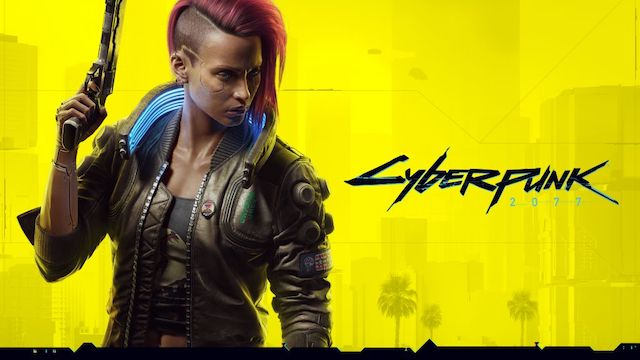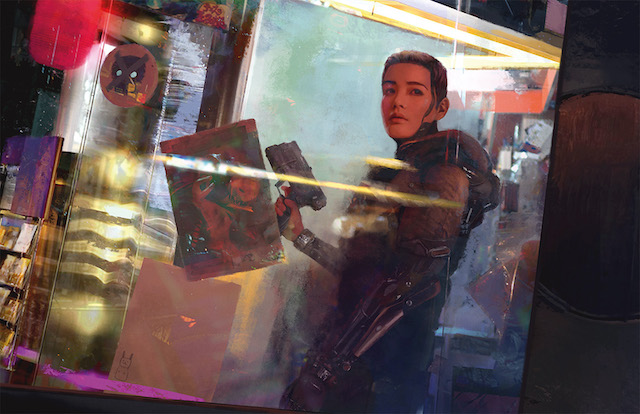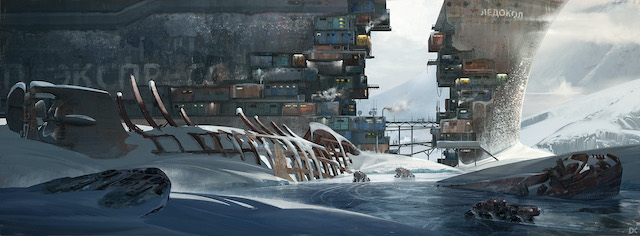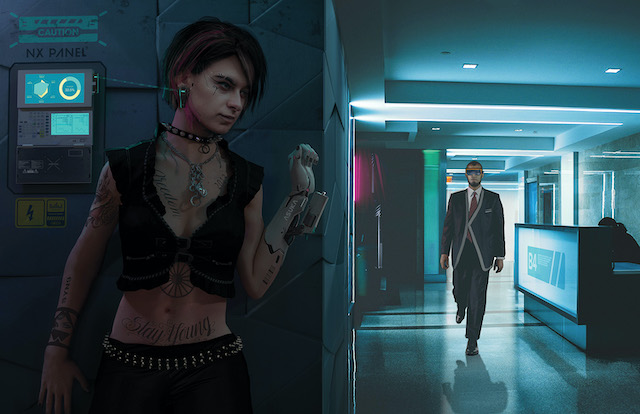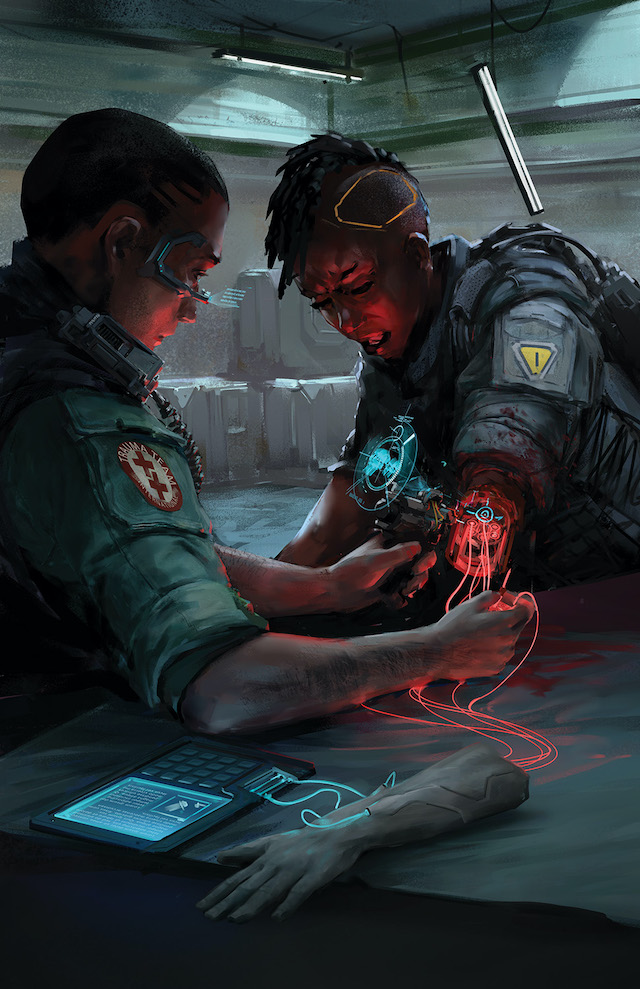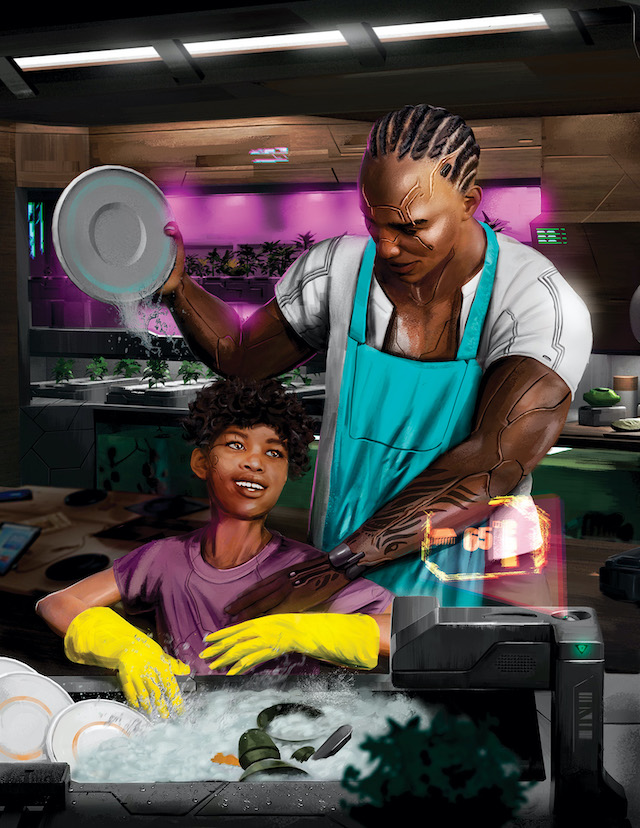Cyberpunk Red: Style and Substance
In 1990, R. Talsorian released Cyberpunk 2020, a revision to the original game from the 1980s. This was followed by many supplements and the gaming world had a tabletop RPG that enabled players to engage with a world with elements they saw and read in Blade Runner, Hardwired, Neuromancer, and Strange Days. The game proved so popular that many still play it today. When a third edition was released, it proved so unpopular that it is basically forgotten.
A few years ago the creators of The Witcher video game series, CD Projekt Red, reached out to R. Talsorian. See, they had played Cyberpunk 2020, and they wanted to create a new video game and thought it might be fun to use Cyberpunk 2020 as the basis. Thus, Cyberpunk 2077 — a much anticipated video game — was born.
Image by CD Projekt Red
R. Talsorian had been working on a Cyberpunk 2020 revision (again, that third edition has been erased from history almost as thoroughly as Pharaoh Akhenaten has been). They unveiled at Gen Con 2019 the Cyberpunk Red Jumpstart Kit. Both Cyberpunk 2077 and Cyberpunk Red have since been intrinsically linked, with growing anticipation about their releases and some minors frustration at delays. That’s how invested people are into the games — a delay of 21 days for Cyberpunk 2077 (albeit, another delay in a series of delays common to the video game industry) sent many raging and vowing to never pay CD Projekt Red a dime again.
When R. Talsorian indicated a delay in the Cyberpunk Red core rulebook, some had a similar reaction. Unfairly, I think during these days of COVID and natural occurrences in creating content.
The questions around Cyberpunk Red inevitably come down to:
- I’m a longtime Cyberpunk 2020 game master (GM) and player; do I get Cyberpunk Red?
- I’m going to play Cyberpunk 2077, and I am new to tabletop RPGs; do I get Cyberpunk Red?
- I’ve played other tabletop RPGs but never Cyberpunk 2020; do I get Cyberpunk Red?
The answer to all three questions is: Yes. Emphatically yes.
Cyberpunk Red achieves the incredible undertaking of revising a beloved classic to modern RPG sensibilities, retaining the core of what made it a classic, and serving as an entry point for new players to RPGs. It achieves both a level of depth and simplicity that every RPG should be so lucky to achieve.
Art by Eve Ventrue
For those unfamiliar with Cyberpunk 2020’s setting, it takes place in a future different from ours in that it took a different path. The Soviet Union managed to survive, and a series of wars, plagues, and economic depression tore at the fabric of civilization. The United States breaks apart, much of the Middle East is destroyed in a nuclear exchange. Africa becomes the center of low-earth orbit habitats. Corporations, in traditional cyberpunk form, became more powerful than nations. A near anarchy dominates.
Additionally, technology advances rapidly, and people are able to replace limbs, organs, and even bodies with cyberware — to enhance their abilities or just to look cool. Cyberpunk Red embraces this alternate history rather than revising its background history for the collapse of the Soviet Union and the US’s global war on terror. They keep to the advancement of technology as if the world of 2020 was the real world, so Cyberpunk Red has a bit of a retro-futurism vibe.
In Cyberpunk 2020, the default setting for the characters is Night City, an independent city along the coast of California, in 2020. Two major corporations — Arasaka and Militech — first engage in a proxy war and then directly in what is called the Fourth Corporate War. This effectively ends when a pocket nuke is detonated in downtown Night City.
Art by Darius Kalinauskus
The result of the nuke, orbital rocks pushed down to collide with Earth, and general environmental pollution results in a blood red sky: The Time of the Red. Players in Cyberpunk Red begin in 2045. Night City is on the way to recovering from the nuke. Corporations are not as powerful as they were — but make no mistake, they are powerful and looking to reclaim lost power. Civilization never went truly post-apocalyptic, but it was darn close. How do the characters make their way in this world? Who is trying to take what they have or what they care about?
Players of Cyberpunk 2020 will recognize instantly that Cyberpunk Red shares the same DNA. Its core mechanics — add up your attribute and skill ranks, roll a D10, add them all together, and beat a target number — remain the same. Criticals explode once: Roll a 10, roll it again. Add both to your number. Roll a 1, roll it again. Subtract both from your number.
The character roles are familiar: Solo, Fixer, Rockerboy, Netrunners, Techs, Medias, Execs, Lawmen, Medtechs, and Nomads. The default setting of the game, Night City, remains the default setting.
The core rulebook starts off with a reprint of a short story that appeared in the Cyberpunk 2020 rulebook that tells the exploits of Johnny Silverhand’s assault on Arasaka’s Night City headquarters to save his girlfriend, who had been kidnapped. This contains in it one of the underpinnings of cyberpunk Mike Pondsmith — creator of the game — often references. For characters in Cyberpunk it is all personal. Sure, people may bring down the evil corporation, but they are not fighting the corporation to bring it down. No. They’re fighting to save their lover or their family or get back that million eurobucks stolen from them. It’s all personal.
The game includes a short section on what a tabletop RPG is along with its basic concepts. This is a necessary element to help ease new gamers into the hobby.
Next, the book describes the roles at a high level along with what their Role Ability is. Each of the roles has a specific extra ability assigned to it that is only open to characters in that role — only Solos have access to Combat Senses and only Execs have access to Teamwork. These abilities are familiar, but they’ve been substantially revised and expanded upon. Previously, they were treated as special skills, but now they are given much more nuance and customization.
For example, in Cyberpunk 2020, the Corporate’s special ability was Resources. A single paragraph in the rulebook in the skills section described it. In Cyberpunk Red, the Corporate role and special ability have been renamed Exec and Teamwork, and the Teamwork special ability is documented on five pages.
This is not a mindless, frivolous expansion of the ability, however. The special ability, which allows the Exec player to have up to three NPCs provided by the corporation as team members, each with a a set of skills and loyalty to their Exec. These team members may appear to be a personal trainer or stylist, but they are actually a body guard or covert operative with their own set of skills, stats, and equipment to bring to the job.
Art by Adrian Marc
This is a place where Cyberpunk Red adds complexity and depth, but does so that is smart. The underlying mechanics continue to function, and only players with Exec characters and the GM need to worry about the details. And this addition of complexity and depth is balanced throughout the rules.
And in true Cyberpunk fashion, if one your team members is killed, HR will replace the team members — though some bribes in the form of hiring fees are necessary and the replacement knows what happened to their predecessor, hurting initial starting loyalty.
All the role special abilities have been revised and have much more interesting variation and options. The Tech’s Maker ability now feels like the embodiment of William Gibson’s statement, “the street finds its own uses for things.” Gone is the jury-rig skill from the 2020 edition. Now they get to choose and build on Field Expertise, Upgrade Expertise, Fabrication Expertise, Invention Expertise. In fact, for Invention Expertise, the game designers give a warning:
“More than any ability in the game, this ability can result in game imbalance. Your GM might need to retroactively change the way your invention operates rules-wise (or, in extreme circumstances, even replace it with another invention of an equal price category that you collaborate on together) several times before you find a version that works well at your table and doesn’t negatively impact game balance.”
You can build your characters now in three different ways:
- The traditional Lifepath (called the Complete Package) uses the traditional tables and rolling to develop a background for your character. This remains the most satisfying way to generate characters and allows for serendipitous surprise and potential story elements. Cyberpunk Red includes specific options for each of the roles.
Part of the Lifepath options
- Streetrats provides a series of templates for each role. You make a few rolls and you have a character ready to go — statistics, skills, equipment, and cybergear.
- Edgerunners attempts to balance between the Complete Package and Streetrats. It tends more toward the Streetrats templates but includes a few more rolls and options in choosing skills, equipment, and cybergear.
Cyberware templates for Streetrat character creation
You measure your characters via ten Statistics: Intelligence, Willpower, Cool, Empathy, Technique, Reflexes, Luck, Body, Dexterity, and Movement. These convert to Hit Points and Humanity. Characters have 66 Skills from which to choose.
Humanity remains mostly unchanged from Cyberpunk 2020. The primary mechanism powering Humanity is the integration of non-voluntary cyberware into the body — that full chrome arm is going to cost you. Replacing that fully functional hand with a cybernetic version with talons? That’s going to cost you.
As the person integrates this kind of cyberware, every piece comes at a cost. Your Humanity score drops. Start at 50, when you hit 49, the character’s Empathy state falls to 4. Hit 39, and it falls to 3. With therapy, you can repair your psyche, but the danger of falling into a state of permanent cyberpsychosis could mean you end up with a character that is out of the player’s control and hunted by the Psycho Squad.
The book has six pages of cyberware to get your character the edge they need to survive in Night City. Cyberoptics, pain editors, amplified hearing, subdermal armor, rippers, scratchers, and borgware.
Art by Anselm Zielonka
Combat will be quite familiar to Cyberpunk 2020 players. The system has been streamlined to make the overall system less crunchy but still preserve a fair amount of the complexity and realism that players have enjoyed for so many years. One of the biggest changes is in how autofire is used:
“Autofire has been reworked for speed of play. Instead of directly modeling individual bullets, we’ve moved to modeling patterns of bullets. Being skilled at keeping an automatic weapon on target allows you to bring out the best in Autofire.”
Autofire is now a specific skill. When you hit while using autofire, you roll 2D6 and multiply it by the amount you beat the target number, though each weapon has a different maximum multiplier.
For example, Minerva is trying to blast her way out of the Biotechnica office and three corpo security goons stand in her way about six yards in front of her. She shoots at them on autofire. She rolls 1D10 and adds her Reflexes (6) and Handgun skill (4). She rolls for a total of 18, which beats the target number by 3. Good job for her, for the maximum damage multiplier her submachine gun has is 3. She rolls 2D6 for a total of 5 and multiplies it times 3 for a total damage of 15. Armor reduces that damage, but she walloped them good. Players will still find that using a shotgun can be devastating when using buckshot instead of slugs.
Art by Neil Branquinho
For RPG veterans, they will see much that is familiar in the combat rules, which allow a character to take one move action and one other action. Cyberpunk Red has simplified hit locations (no more), armor stacking (no more), but added critical injuries (including one for aimed shots at the head). Critical injuries are triggered when two sixes are rolled on the damage roll. Cover and armor have been simplified: characters are or are not behind cover, armor does not stack, and it covers either head or the body. However, the game retains its tactical nature and the simplifications reduce bookkeeping and keep the focus on what’s happening in the game. All without altering the deadliness of the combat or the “feel” that this is a Cyberpunk game. Cyberpunk has explicit instructions for using humans — alive or dead — as shields because, well, it is the dark future.
One of the biggest knocks against Cyberpunk 2020 was the hacking or netrunning rules. Essentially a separate game — spawning a playable card game that has its DNA all the way into Shadow of the Beanstalk cyberpunk tabletop RPG by Fantasy Flight Games — many gaming groups avoided it entirely. The Cyberpunk Red Jumpstart Kit included the new netrunning rules with a limited number of pieces of software. The full rulebook includes the same rules but more programs and Black Ice (a type of program that hunts down netrunners and their programs).
Using the advanced timeline to good benefit, the old Net essentially went away in the DataKrash (remnants of it remain, but it is deadly). The replacement is disconnected and requires the netrunner to be in physical proximity to the network access points. This ensures that netrunners cannot be miles away doing their own thing while the rest of the team engages the physical site. This critical change removes the “separate game” complaint and provides a real reason for each player group to have a netrunner.
Art by Eve Ventrue
The rules provide guidance and tools for GMs to create their own networks, including Demons:
“These ‘Demons’ are designed to attack Meatspace targets, such as a Netrunner’s support party, using Control Nodes, like drones and turrets.”
Nearly half the rulebook is full of the history of the world that brought about the game world players are in, including the transition of Night City post the nuke, gangs, daily life, and so on. New players to this incredibly rich and detailed history might be best served starting with the “Welcome to Night City” chapter to get a more manageable and digestible dose of the lore before undertaking the “Welcome to the Dark Future” and “The Time of the Red” chapters.
Art by Pedram Mohammadi
The “Running Cyberpunk” chapter is an excellent resource for GMs wanting to run Cyberpunk Red. Any game for that matter. (Listen Up You Primitive Screwheads has remained a touchstone for many GMs in how to run games).
I have barely scratched the surface of this 456-page tome, which speaks, I think, to the masterful simplifying of the rule set but yet added depth and complexity to the way those rules can be utilized, character options, and so on. The is a must-buy game for any player of Cyberpunk 2020, any player of science fiction-themed RPGs, or any player interested in RPGs.
Cyberpunk Red will be played thirty years from now like its earlier edition. A slam dunk.
Patrick Kanouse encountered Traveller and Star Frontiers in the early 1980s, which he then subjected his brother to many games of. Outside of RPGs, he is a fiction writer, avid tabletop roleplaying game master, and new convert to war gaming. His last post for Black Gate was Mutants and the End of the End of Days: Mutant Year Zero. You can follow him and his brother at Two Brothers Gaming as they play any number of RPGs. Twitter: @patrickkanouse. Facebook: Two Brothers Gaming

